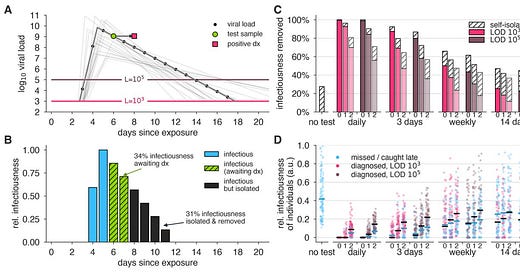12/7—Effective testing depends on frequency and speed of reporting, not sensitivity
Test sensitivity is secondary to frequency and turnaround time for COVID-19 screening
After infection, individuals undergo a period of incubation during which viral titers are usually too low to detect, followed by an exponential viral growth, leading to a peak viral load and infectiousness, and ending with declining viral levels and clearance. Given the pattern of viral load kinetics, we model the effectiveness of repeated population screening considering test sensitivities, frequency, and sample-to-answer reporting time. These results demonstrate that effective screening depends largely on frequency of testing and the speed of reporting, and is only marginally improved by high test sensitivity.

What's next for COVID-19 apps? Governance and oversight
The rapid deployment of digital contact tracing (DCT) apps represents one of the largest experiments in public health surveillance ever attempted—and certainly the first one relying so strongly on digital platforms. We have argued that DCT governance should be focused on evidence collection and planned adaptation to address numerous uncertainties.
Airflows inside passenger cars and implications for airborne disease transmission
A passenger car cabin represents one such situation with an elevated risk of pathogen transmission. Here we present results from numerical simulations to assess how the in-cabin microclimate of a car can potentially spread pathogenic species between occupants, for a variety of open and closed window configurations. An air flow pattern that travels across the cabin, farthest from the occupants can potentially reduce the transmission risk.
Breath-, air- and surface-borne SARS-CoV-2 in hospitals
14 patients including 10 COVID-19 subjects were recruited; exhaled breath condensate (EBC), air samples and surface swabs were collected and analyzed for SARS-CoV-2 using RT-PCR in four hospitals with applied natural ventilation and disinfection practices in Wuhan. We discovered that 22.2% of COVID-19 patients (n = 9), who were ready for hospital discharge based on current guidelines, had SARS-CoV-2 in their exhaled breath (~105 RNA copies/m3). Use of breath sample as a supplement specimen could further guard the hospital discharge to ensure the safety of the public.
Mitigating a COVID-19 Outbreak Among Major League Baseball Players — United States, 2020
During the 2020 season, Major League Baseball instituted a multilayered COVID-19 prevention and mitigation strategy. In an outbreak among 20 baseball players and staff members on a single team, no secondary transmission during field play between two opposing teams occurred. Interactions outside of game play were the likely source of transmission within the team.
Get it by email:
Missed an update? View past issues.

